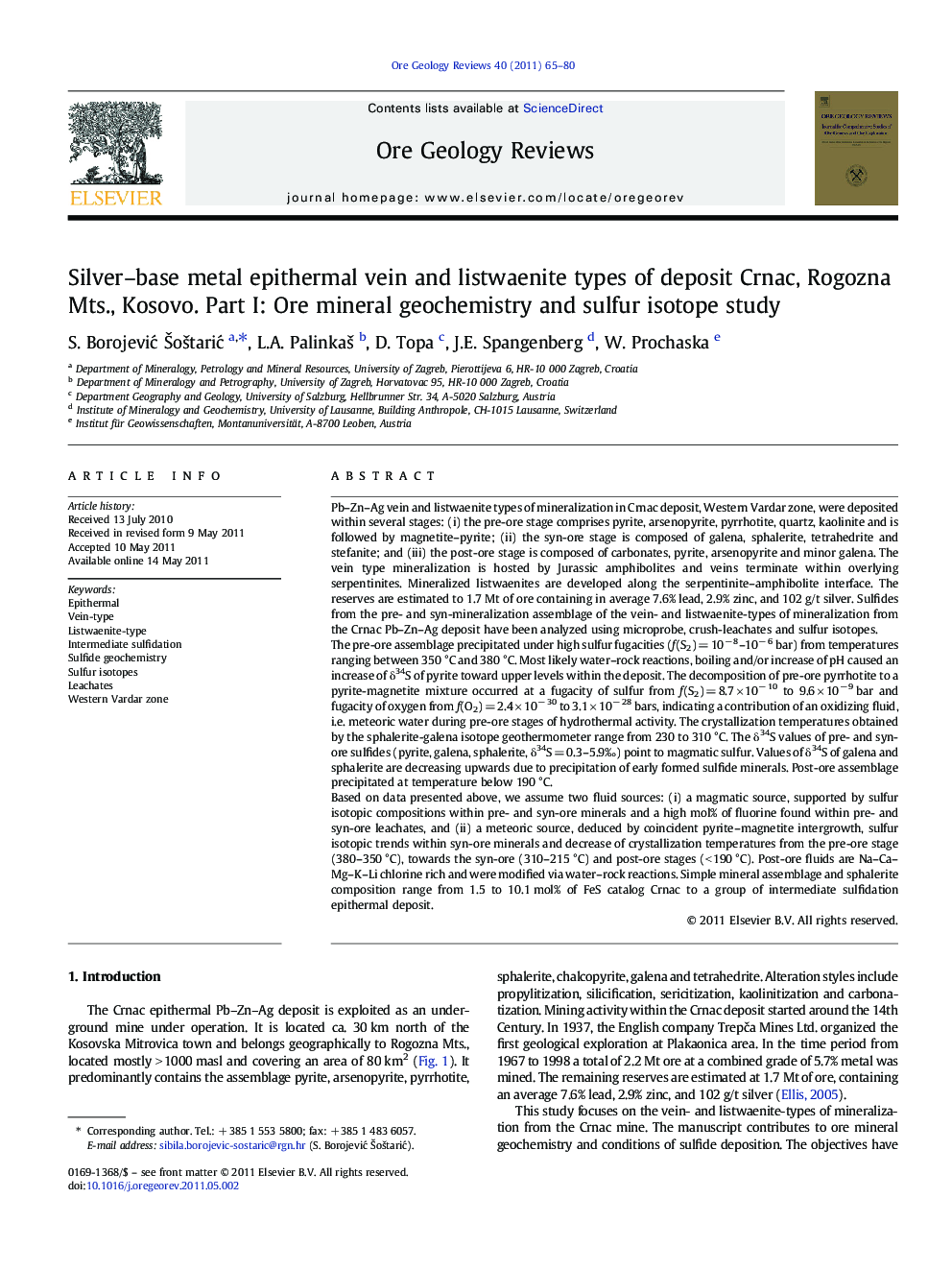| کد مقاله | کد نشریه | سال انتشار | مقاله انگلیسی | نسخه تمام متن |
|---|---|---|---|---|
| 4697720 | 1637260 | 2011 | 16 صفحه PDF | دانلود رایگان |

Pb–Zn–Ag vein and listwaenite types of mineralization in Crnac deposit, Western Vardar zone, were deposited within several stages: (i) the pre-ore stage comprises pyrite, arsenopyrite, pyrrhotite, quartz, kaolinite and is followed by magnetite–pyrite; (ii) the syn-ore stage is composed of galena, sphalerite, tetrahedrite and stefanite; and (iii) the post-ore stage is composed of carbonates, pyrite, arsenopyrite and minor galena. The vein type mineralization is hosted by Jurassic amphibolites and veins terminate within overlying serpentinites. Mineralized listwaenites are developed along the serpentinite–amphibolite interface. The reserves are estimated to 1.7 Mt of ore containing in average 7.6% lead, 2.9% zinc, and 102 g/t silver. Sulfides from the pre- and syn-mineralization assemblage of the vein- and listwaenite-types of mineralization from the Crnac Pb–Zn–Ag deposit have been analyzed using microprobe, crush-leachates and sulfur isotopes.The pre-ore assemblage precipitated under high sulfur fugacities (f(S2) = 10− 8–10− 6 bar) from temperatures ranging between 350 °C and 380 °C. Most likely water–rock reactions, boiling and/or increase of pH caused an increase of δ34S of pyrite toward upper levels within the deposit. The decomposition of pre-ore pyrrhotite to a pyrite-magnetite mixture occurred at a fugacity of sulfur from f(S2) = 8.7 × 10− 10 to 9.6 × 10− 9 bar and fugacity of oxygen from f(O2) = 2.4 × 10− 30 to 3.1 × 10− 28 bars, indicating a contribution of an oxidizing fluid, i.e. meteoric water during pre-ore stages of hydrothermal activity. The crystallization temperatures obtained by the sphalerite-galena isotope geothermometer range from 230 to 310 °C. The δ34S values of pre- and syn-ore sulfides (pyrite, galena, sphalerite, δ34S = 0.3–5.9‰) point to magmatic sulfur. Values of δ34S of galena and sphalerite are decreasing upwards due to precipitation of early formed sulfide minerals. Post-ore assemblage precipitated at temperature below 190 °C.Based on data presented above, we assume two fluid sources: (i) a magmatic source, supported by sulfur isotopic compositions within pre- and syn-ore minerals and a high mol% of fluorine found within pre- and syn-ore leachates, and (ii) a meteoric source, deduced by coincident pyrite–magnetite intergrowth, sulfur isotopic trends within syn-ore minerals and decrease of crystallization temperatures from the pre-ore stage (380–350 °C), towards the syn-ore (310–215 °C) and post-ore stages (< 190 °C). Post-ore fluids are Na–Ca–Mg–K–Li chlorine rich and were modified via water–rock reactions. Simple mineral assemblage and sphalerite composition range from 1.5 to 10.1 mol% of FeS catalog Crnac to a group of intermediate sulfidation epithermal deposit.
Research highlights
► Intermediate sulfidation, epithermal Pb-Zn-Ag vein and listwaenite type of deposit Crnac, Western Vardar zone.
► Pre-ore pyrite, arsenopyrite, pyrrhotite, quartz, kaolinite; syn-ore galena, sphalerite, tetrahedrite; post-ore carbonates.
► Pre-ore stage: f(S2) = 10− 8–10− 6 bar to f(S2) = 8.7 × 10− 10 to 9.6 × 10− 9 bar; f(O2) = 2.4 × 10− 30 to 3.1 × 10− 28 bars, t = 350–380 °C.
► Syn-ore stage: t = 230–310 °C; d34S = 0.3 – 5.9 ‰.
► Post-ore stage: t < 190 °C; Na-Ca-Mg-K-Li chlorine rich fluid.
► Mixture of magmatic and meteoric water.
Journal: Ore Geology Reviews - Volume 40, Issue 1, September 2011, Pages 65–80